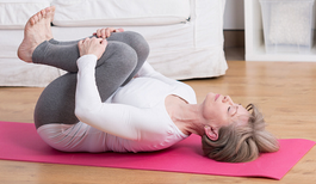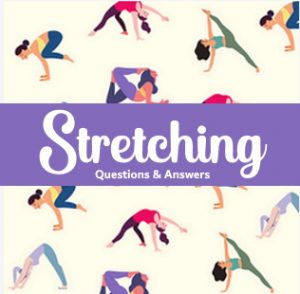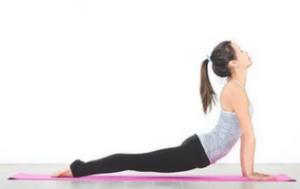There is no doubt that when you have a back ache, it is a real nuisance. The pain can range from a minor quirk to extreme agony. Of course, in the latter situation, you will want to seek professional medical attention.
But if you are trying to smooth out the kinks from your day’s work, or from enjoying one of your regular activities, we have the answer to reduce the discomfort, and set you up for a system of building overall strength, and incrementally increasing flexibility.
Stretches to relieve lower back pain can and will help you with not only the discomfort you feel, but also, to recondition your body to work in harmony with all the muscles and tendons that support the bones and joints.
Healthcare Professionals Practice Stretch Therapy
Serious back issues need to be addressed with a qualified practitioner. Yet, what is more encouraging nowadays is that doctors, physical therapists, osteopaths, and chiropractors are all embracing stretching as a tried and true method of treatment for many aches and pains, as well as specific upper and lower back conditions.
They are seeing stretches as a way to better health regardless of the level of pain. Like we need good nutrition for our bodies to flourish, so do our skeletal elements need a routine of consistent activity to stay healthy and keep us going until our later years in life.
Indeed, stretching is not a fad, nor is it nonsense created just to sound good or as a package for people that can afford it. There is no hype, and it is not expensive.
Everyone can find a way to make stretching work for them. And many stretches to relieve lower back pain can be done anywhere and without equipment.
The trend for its usage is rapidly shifting upwards, as more studies prove the efficacy and restorative value of the exercises.
Stretches To Help Alleviate Low Back Pain and Tightness
 The back takes a lot of wear and tear throughout one’s lifetime. It is a strong part of the body, yet at the same time, it is quite fragile. It can be damaged in an instant.
The back takes a lot of wear and tear throughout one’s lifetime. It is a strong part of the body, yet at the same time, it is quite fragile. It can be damaged in an instant.
For many people, they feel a tightness in the lower back area that is not always quickly identifiable. They don’t remember hurting their back, per se.
Contrarily, the pain in the back might not even be from an irritated back, but rather an issue with another part of the body.
Because the back is such a large portion of the total body, it tends to compensate for other parts that are not working properly.
For example, when we lift things incorrectly, we put too much strain on the back instead of the body parts that are supposed to support lifting functions. Likewise, if the hamstrings are tight from not exercising, then the back takes up the slack.
Often, we don’t notice at the time what has happened, but after sleeping or lying in bed all night, you wake up with a sore back. The lower back seems tight and not flexible at all from the inactivity.
The best way to handle this is by doing stretches to help alleviate low back pain and tightness in the morning when you get up so that you can start your day refreshed and ready.
Certain stretches not only increase flexibility by loosening tight muscles, but they also realign parts of the body such as the pelvic area, the lower back, and the buttocks.
Bringing individual knees, or even both at the same time, to the chest, is a quick and simple, yet a highly effective stretch.
You can further strengthen the back and hip area by stretching one leg across the other while lying on your back. Your body is somewhat twisted, but in a good way. You should feel the nice stretches to relieve lower back pain.
Once you have done a few repetitions, your body should feel more relaxed, and the discomfort in your back should have subsided. Doing this everyday will ensure a stronger, more mobile back.
Stretches That Are Good For Your Back
Although we highly recommend stretching for many health-related issues, and various aches and pains, we also recognize that you must choose the proper exercises to do.
As we mentioned earlier, the back can be very fragile, and it is important not to make the situation worse. You want to alleviate pain in the lower back, not cause more damage or irritation.
In the past, the approved form of treatment was resting, and abstaining from various activities to heal the discomfort in the back area.
Now, if the condition is not serious, it is understood that stretches to relieve lower back pain are an accepted way to achieve relief, assuming you choose stretches that are good for your back.
- One way to stretch out the soreness and tightness is through massage. Of course, you may need to pay a professional for this service, but it might be worth it.
A massage therapist will know what areas to target and what types of massage touches will help. It would be a good idea to check your health care plan or insurance to see if you can be reimbursed for treatment.
- For some individuals, a foam roller can help to alleviate irritation, and general knots in the back. There are several kinds on the market, so it probably requires a little research before purchasing the right one for your situation.
- Other people benefit from rolling two tennis balls under their back.
- But if you prefer something larger, using a stability ball for stretching out more muscles that support back movement will be ideal.
Choose the method you most enjoy.
The idea with stretching is to avoid chronic pain. By performing the right stretches on a regular basis, you release the tightness, and remove the discomfort.
Finding the proper way to stretch also improves posture, heightens the sensations of relaxation, and releases muscle tension in the neck, decreasing headaches.
Stretching To Relieve Back Pain
It is normal to want to rest when we have a sore back. We assume that by not using it, we can make it better.
Most of the time, however, it is the complete opposite. Stretching strengthens a weak back and inflexible supporting muscles. It is the neglect of the back that will cause a chronic condition. Once you reach that point, it is going to be all that more difficult to turn things around.
While you may require some form of supervision to help set up the exercises and monitor your progress, you can probably continue your stretching on your own in the privacy of your own home.
It is largely undisputed that a consistent regime of stretching will strength the back and core muscles. In turn, this helps with healing acute back pain, and actually, averts another episode of discomfort from happening.
Stretches to relieve lower back pain are meant to help and prevent future injuries. The goal of the routine is to get back to your daily life as quickly as possible.
But, more importantly, for you to keep up the consistency so that you can recondition your body so that it does not hurt all the time.
Stretches To Help With Upper Back Pain
Exercising for your upper back is different than the lower back. Both need to lengthen and strengthen muscles, but they target different areas.
For example, helping the lower back to work at peak performance are the hamstrings, the buttock muscles, and the core muscles.
With the upper back, you want to strength and target the upper arms, shoulders, and neck.
Further, what should be understood about the back in general, is that suffering in the lower, middle or upper sections usually comes from doing things that are incompatible with the way our body really works.
We can’t see the inside of our body, and in many cases do not understand fully how each component works with one another.
We just know we want to complete a certain task, and we do it whether our body cooperates or not.
Moreover, bad posture and repetitive strain make the muscles weak and inefficient. Therefore, when learning about stretches to help with upper back pain, look for poses that focus on the thoracic spine, individual vertebra, and the specific rotation of the upper body.
Typically, when people complain of upper back pain, they need to loosen one or all of these five muscles. They are called:
- Latissimus dorsi
- Rhomboids
- Deltoids
- Upper trapezius
- Levator scapulae
Shoulder blade stretching, as well as side stretches feel really good on the back, and help with improved or continued mobility.
To be honest, we all should be following a routine of stretching to isolate all our muscles.
Final Thoughts on Stretches to Relieve Lower Back Pain
Our backs are precious commodities. Yes, we need all our body to work perfectly, and it is important to take steps to treat and maintain our whole health, but the back is prone to serious injury.
When damaged or even slightly irritated, it becomes increasingly more difficult to complete everyday tasks. A lot of time and money is lost with back aches.
To counter this negative situation, why not adopt an easy routine of stretches to relieve lower back pain, increase mobility, and boost your strength to improve fitness and enjoy your everyday activities?



